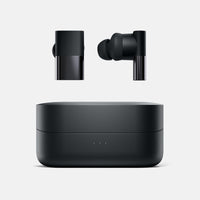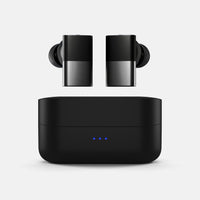
Bit Depth and Sample Rate Explained
It’s become increasingly common for music streaming services to offer "HiFi" options in the form audio files and streams with sample rates as high as 192 kHz and 24 bit resolutions.
But...bit depth? Sample rate? What the hell am I talking about?
If you want to know what the numbers behind the music mean, this one is for you. Let's take a broad look under the digital hood and get into the concepts of sample rate and bit depth, their interplay, and how much these specs really matter when it comes to sound quality.
Bit Depth: The Resolution of Dynamics and Volume
Bit depth can be a little tricky if you're not particularly familiar with audio concepts, so if you're confused by it in this section, keep reading. It will hopefully make more sense when we contextualize it with sample rates later on.
Anyway.
If you use a streaming service that displays its file specifications, you may have noticed that bit depth most commonly comes in two sizes: 16 bit, and 24 bit.
So what are bits?
There are a few ways to explain them. The common explanation is that audio files with higher bit depths offer a greater dynamic range. 16 bits can convey a 96 dB of dynamic range, and 24 bits 145 dB of dynamic range.
But you don’t necessarily have to know what dynamic range is to understand the significance of bit depth. You just have to know this: with a higher bit depth comes a greater number of steps that can represent volume levels. Steps are simply units of volume to which the level of an audio signal conforms. You can think of them as audio pixels: precise points, finite in number and fixed in their value, used to portray something that would otherwise be infinitely gradational if experienced in the real world (volume levels in audio, shades/colors/shapes in images).

16 bit audio offers 65,536 steps, or volume values, while 24 bit audio offers exponentially more steps: 16,777,216 to be precise. 24 bit audio offers a finer gradient — that is, a higher resolution — to depict volume.

Let's take a breather and come back to bits after we talk about sample rate.
Sample Rate: The Resolution of Time and Frequency
Samples are to audio what frames are to video. If you look at your phone’s video settings, you may have the option between recording videos at 30 frames per second or 60 frames per second (FPS). At 30 FPS, one second of video is composed of 30 frames, or simpler yet, 30 still photos. At 60 FPS - well, you can probably guess. When the video file is played back, it rapidly displays these still images sequentially. Our brains piece these stills together, and we're left with the illusion of viewing fluid, continuous movements.
Now let's say you're listening to a song with a 44.1 kHz sample rate. This means that every second of audio in the file is represented with 44,100 individual samples - extremely short audio frames - played in rapid succession. Like the video example, our brains perceive the rapid succession of these stills as a fluid, continuous audio signal.
44.1 and 48 kHz are the industry standard sample rates, but HiFi audio is frequently defined by higher sample rates like 88.2, 96, and sometimes even 176.4 or 192 kHz. An 88.2 kHz sample rate captures twice as many samples per second as 44.1 kHz, and by extension, 176.4 kHz captures 3 times as many.


The Interplay of Sample Rate and Bit Depth
Now let's put it all together.
Sample rate is the resolution of time. The sample rate number refers to how many still moments, or samples, compose one second of audio (44,100 samples per second; 48,000 samples per second; etc).
Bit depth is the resolution of volume dynamics within each sample of audio.
To use video as an example again: sample rate is like frames per second (30 FPS, 60 FPS), while bit depth would be the resolution of each frame (1080p, 4k, etc).

Do Higher Sample Rates and Bit Depths Really Improve Sound Quality?
Back to our video example again: if you've ever seen or shot video at 60 FPS you have likely noticed that the video looks smoother than it does at 30 FPS. More frames per second means our brains have fewer gaps to fill; time is represented at a higher resolution.
So if 60 FPS looks smoother and more realistic than 30 FPS, surely an 88.2 kHz sample rate sounds better/more realistic than audio at a 44.1 kHz sample rate, right?...Right?
Well, not quite. The audiophile marketing centered around higher sample rates conveniently turns a blind eye towards something known as Nyquist Theorem.
Nyquist Theorem posits that audio signals can find accurate representation so long as the sample rate is at least twice the value of the highest frequency contained in the audio recording. If you're not particularly familiar with this type of language, that sentence might leave you scratching your head. All you need to understand can be demonstrated with a few examples:
- 20 Hz sounds need a 40 Hz sample rate at minimum for accurate reproduction.
- 100 Hz sounds need 200 Hz sample rates.
- 500 Hz needs 1 kHz sample rates...you get the point.
The range of human hearing is 20 Hz to 20 kHz. To accurately represent the full range, we in theory only need a 40 kHz sample rate in order to accurately capture that 20 kHz ceiling. Thus, we can use Nyquist Theorem to deduce that the regular old sample rates of 44.1 and 48 kHz are more than sufficient for accurate sound reproduction. As for the 88.2 or 96 kHz sample rates? Well, they're probably not making much of a difference. Higher sample rates are useful in audio science and music production for some interesting reasons that go beyond the scope of this explanation. But for simply listening to your music, Nyquist Theorem tells us that 44.1 and 48 kHz are serving you just fine.
Interestingly, there is no Nyquist Theorem equivalent when it comes to bit depth and its relationship to volume dynamics. So, there seems to be a little more credence to claims that there's an audible difference between 16 bit and 24 bit audio. How audible this difference is, however, entirely depends on who you ask.
But with all of that said, a lot of the music you listen to these days is in a 44.1 kHz / 16 bit resolution - and it doesn't get much better than that. You can most likely enjoy your music as is.





